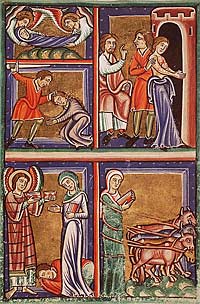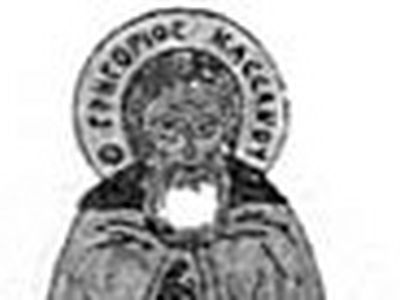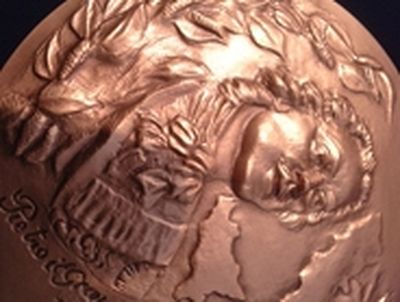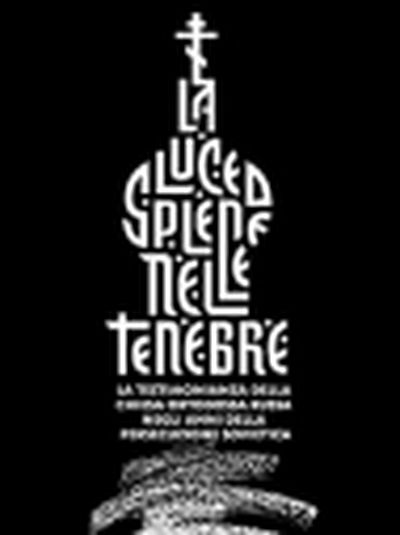 Scenes from life of saint Agatha of Palermo
Scenes from life of saint Agatha of Palermo
|
| Scenes from life of saint Agatha of Palermo |
5. The Norman Conquest and the Decline of Byzantine Influence
By the middle of the eleventh century the tension between the Churches of Constantinople and Rome, which had begun centuries earlier, had greatly increased. Among the causes for this were exaggerated claims of universal papal authority over the rest of the Churches, the insertion of the “filioque” clause into the Nicene Creed, novelties in some of Rome’s liturgical practices, and disputes over local jurisdiction in the Balkans and Southern Italy. This culminated in the Schism of 1054 and the mutual excommunications of the Byzantine and Roman Churches.
At the same time, the Normans began a series of attacks, winning their first battles against the Byzantines in 1041. At first Pope Leo IX opposed the Normans, and was even willing to ally himself with the Byzantine emperor Constantine IX Monomachus against them. However, due to the above-mentioned theological dispute, the papal legates, sent to Constantinople to negotiate this, instead entered into polemical arguments with the patriarch, and ended by excommunicating him, thus precluding an alliance. By 1071 the Normans took all of Southern Italy, and by 1091 they completed their conquest of Sicily from the Saracens.
In 1059 the next pope, Nicholas II, desiring to increase papal power and reestablish authority over Southern Italy, met with the Norman leader Robert Guiscard and recognized him as the “Duke of Puglia and Calabria and future Duke of Sicily” in exchange for Robert’s oath of loyalty to the pope. Robert swore to place all the churches in his state under papal jurisdiction, and thus the survival of these churches came to depend on their recognition of Rome’s jurisdiction. Robert considered Constantinople his enemy, and so to assure loyalty to himself in Southern Italy he gradually replaced the Italo-Greek bishops with Latin ones or found Greek bishops who would be loyal to Rome. In Sicily, still occupied by the Saracens, the minority Orthodox Christians at first thought of the Normans as their liberators, and in fact helped them to take the island from the Muslims, a process that took about thirty years. The Latinization of Southern Italy and Sicily was a slow process. In Calabria the Normans replaced Greek bishops when they could, and when this was not possible due to local opposition, they exacted only loyalty to Rome. Although some dioceses remained Greek until much later (Gallipoli in Puglia remained so until 1513), the majority were Latinized far earlier. Opposition to Latin domination continued for quite some time among the clergy, who in general identified themselves as Byzantines. Many monastics remained Orthodox until the twelfth century. In Sicily, due to the ecclesiastical disarray caused by long years of Saracen control, the Norman count Roger I (1071–1101) set about the reorganization of the Church, appointing numerous Latin bishops.
At the beginning of the Norman takeover of Southern Italy, many small monasteries, especially in the northernmost areas, were devastated. Robert began to encourage Benedictine monasticism throughout the territory so as to offset the influence of Italo-Greek monasticism, giving some of the Greek monasteries to the Benedictines as dependencies. The situation was different in Sicily, where the Normans endowed Italo-Greek monasteries in an effort to win the loyalty of the population. In addition, Roger I and his son King Roger II came to admire the Byzantine civilization and culture, and many Italo-Greeks served in the Norman government.
As Roger I consolidated his power in Sicily, his policy became one of appointing Latins to high ecclesiastical office, while allowing the Italo-Greeks to hold onto their monasteries and churches, even founding new ones himself, such as the monasteries of St. Michael of Troina and St. Elias of Ebulo. His son continued this policy for much of his reign, founding fifty-three Italo-Greek monasteries by 1134.
During the Norman rule, which now offered external economic and political stability, Italo-Greek monasticism gradually changed to emphasize coenobitism, with large endowed monasteries governed by set monastic rules, such as those of St. Sabbas and St. Theodore the Studite. Eremitic life still existed, but was now more of an exception. Monasteries became much larger, with many churches, buildings, libraries and scriptoria. In addition to spiritual literature, secular literature and the classics were studied. The previous informal federations of monasteries were replaced by a more rigid and institutional framework. Reasons for this change include the strong Latin influence on the Italo-Greek monasteries, the decline of the standard of monastic life in these monasteries during the eleventh century, and the desire of the Normans to replace the spiritual bond that had joined the Italo-Greek monasteries to Constantinople with a more juridical bond under their own authority — and gradually under the authority of the Latin popes. In addition, the Normans were also attempting to fit Italo-Greek monasticism into their concept of feudal society. On the other hand, there was already a movement from within these monasteries to institute the earlier reforms of St. Theodore the Studite, which emphasized coenobitism and defense of the Faith. All of these elements worked together in varying degrees to bring about a revival of the quality of monastic life, which had suffered desolation in Sicily from the Saracens and in Southern Italy from the initial Norman invasion.
This revival was, however, short-lived. By the twelfth century the Greek-speaking population of Sicily and Southern Italy had been effectively cut off from the spirituality and culture of the Byzantine East. The Latin population and culture around them grew and gradually absorbed them, causing decadence among them and their monasteries. In Sicily, now that the Saracen threat had decreased Roger II no longer needed the support of the Italo-Greeks and began to give greater support to the Latins. At last, as Latinization increased, during the fouteenth century the Italo-Greeks either emigrated to the East or lost their identity, and the great flowering of Orthodox monasticism in Magna Graecia came to an end.
Nonetheless, today, with the monolithic character of Roman Catholicism beginning to wane in Southern Italy and Sicily, the great heritage of the region’s Orthodox saints remains firm. With the new immigration to these lands of Orthodox people from Eastern Europe and the conversion of local Italians to the Orthodox Faith, the Orthodox Church and its monasticism are beginning to reemerge. In recent decades it has become possible once again to offer an Orthodox witness in the land of Southern Italy. Through the prayers of the Orthodox saints of Italy, may it be so! Sources:
Fr. David Paul Hester. Monasticism and Spirituality of the Italo-Greeks. Thessalonica: Patriarchal Institute for Patristic Studies, 1991. Hieromonk Alessio. I Santi Italo-Greci Dell ‘Italia Meridionale; Epopea Spirituale Dell ‘Oriente Cristiano (The Italo-Greco Saints of Southern Italy: The Spiritual Epic of Eastern Christianity). Calabria, Patti [Messina]: Nicola, 2004. Iconographic sketches throughout this Calendar are by Luigi Merulla, from Hieromonk Alessio’s book.
Thanks to Fr. David Hester, Deacon Joshua and Diaconissa Lucia Resnick, and Giovanni Tallino for their assistance.



